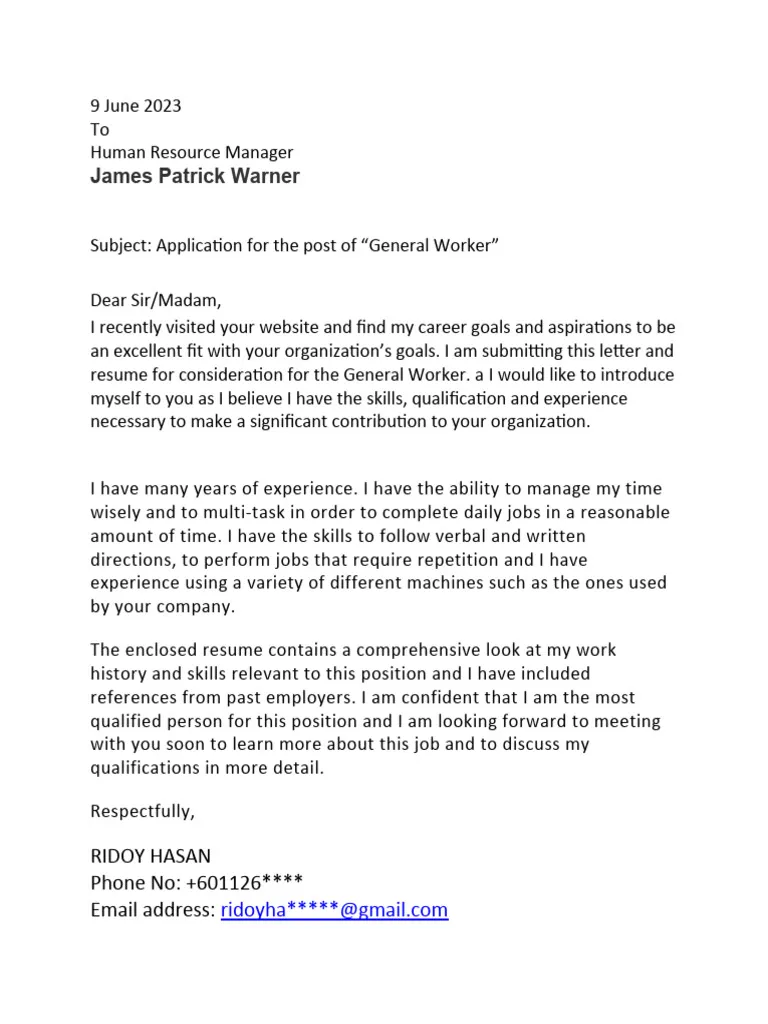Understanding the Importance of a Labourer Cover Letter
In the competitive world of construction and manual labor, securing a job often hinges on more than just your resume. A well-crafted cover letter for a labourer position is your first opportunity to make a strong impression on potential employers. It provides a platform to articulate your suitability for the role, demonstrating not only your skills and experience but also your enthusiasm and commitment to the job. Ignoring the significance of a cover letter can be a significant setback, as it means missing out on the chance to personalize your application and stand out from other candidates. A cover letter allows you to highlight specific achievements and tailor your application to the requirements of the job, significantly increasing your chances of getting hired. Remember that the cover letter is your personal introduction, setting the stage for your interview and career in the field.
Why a Cover Letter Matters for Labourer Jobs
While a resume provides a brief overview of your qualifications, a cover letter offers a deeper dive into your personality and motivations. It allows you to connect with the employer on a more personal level, which is particularly valuable in manual labor jobs where teamwork, attitude, and reliability are paramount. Think of your cover letter as a chance to show your enthusiasm for the role, your knowledge of the company, and your commitment to safety and quality. By demonstrating these qualities, you can set yourself apart from other applicants and greatly improve your chances of getting an interview. Furthermore, it’s an opportunity to address any gaps in your employment history or explain your reasons for seeking a new job. A cover letter is your chance to control the narrative and present yourself in the most favorable light possible.
Highlighting Your Key Skills and Experience
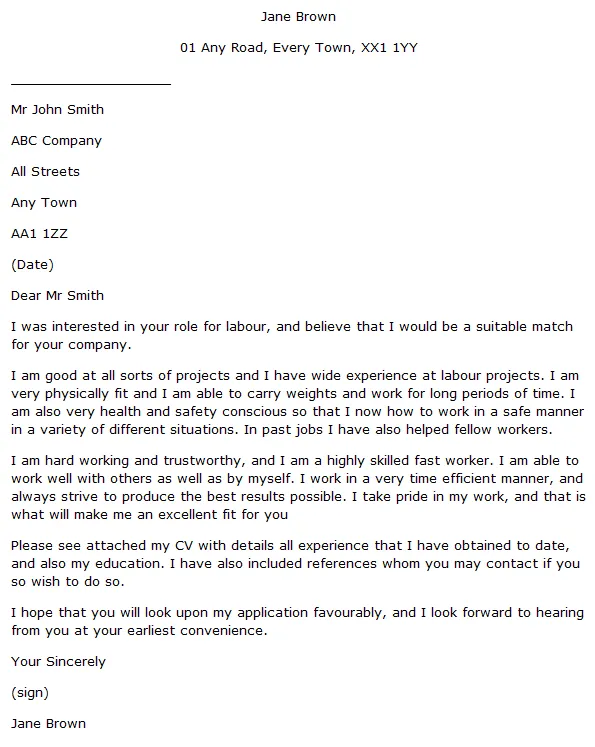
A successful labourer cover letter should clearly showcase your most relevant skills and experience. It is crucial to go beyond simply listing your qualifications and instead, demonstrate how your skills have benefited previous employers. By providing concrete examples and quantifiable results, you can strengthen your claims and persuade the hiring manager that you are the right candidate for the job. For instance, if you have experience in operating specific equipment or machinery, be sure to mention them and explain your proficiency. Similarly, highlight any specialized training or certifications you possess, as these can significantly increase your value to a potential employer. The emphasis should always be on showcasing your practical abilities and your proven track record.
Essential Skills for Labourers to Showcase
Construction and manual labor jobs demand a diverse range of skills. When writing your cover letter, focus on the skills most relevant to the specific role you are applying for. Some essential skills to highlight include physical stamina and strength, the ability to follow instructions, teamwork and collaboration, problem-solving abilities, and a strong work ethic. Other vital skills include operating tools and machinery, the ability to understand and implement safety protocols, and any specialized skills like carpentry, plumbing, or electrical work. If you’ve worked with any specific materials like concrete, wood, or steel, it’s essential to mention it. Providing examples of how you’ve used these skills in previous roles will help demonstrate your competence and adaptability.
Experience and Projects to Mention
When describing your experience in your cover letter, make it clear and specific. Instead of simply saying you worked on construction sites, detail the types of projects you worked on and your specific responsibilities. Did you work on residential, commercial, or infrastructure projects? Did you assist with site preparation, demolition, or other tasks? Quantify your accomplishments whenever possible. For example, mention the number of projects you have been involved in or the size of the construction sites you’ve worked on. Highlighting specific projects demonstrates a clear understanding of the work involved and your capacity to contribute effectively. Provide details about your experience, showing the types of tasks you are familiar with and your ability to work efficiently and safely.
Formatting Your Labourer Cover Letter
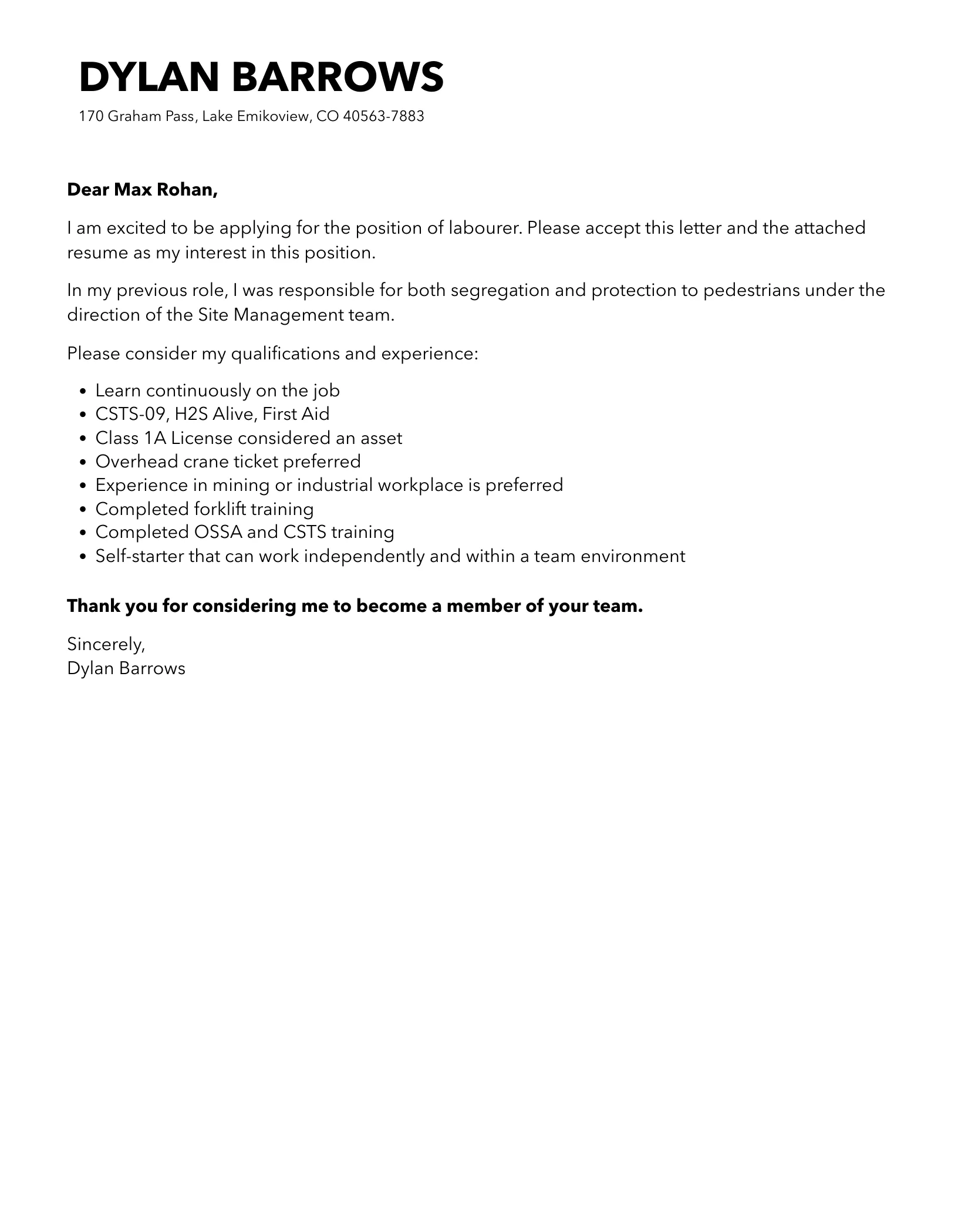
A well-formatted cover letter is visually appealing and easy to read. This ensures that the hiring manager can quickly grasp the key information about your qualifications. Proper formatting also demonstrates professionalism and attention to detail, which are essential qualities for a labourer. Formatting should include clear sections, consistent fonts, and ample white space. The letter should be concise, typically no more than one page long, and should be tailored to the specific job you are applying for. Avoid using a generic cover letter; personalize it for each application by researching the company and job requirements and mentioning how your skills and experience align with their needs.
Header and Contact Information
Begin your cover letter with a professional header that includes your full name, address, phone number, and email address. You should also include the date and the name and address of the hiring manager or company you are applying to. Make sure the contact information is accurate and up-to-date, as this is the primary way the employer will contact you. Ensure the header is neatly aligned and easy to read. This is a crucial first step in making a positive impression, showing that you have paid attention to detail. If you cannot find the hiring manager’s name, address the letter to the hiring department or use a general salutation.
Proper Salutation and Tone
Choosing the right salutation and tone is vital for making a good first impression. Always start with a professional greeting. If you know the name of the hiring manager, use ‘Dear Mr./Ms. [Last Name]’. If you’re unsure, use a general salutation like ‘Dear Hiring Manager’. The tone of your cover letter should be formal and professional, yet personable. Convey enthusiasm for the role and the company. Avoid sounding overly casual or informal. Always write in a positive and confident tone, focusing on your skills, experience, and achievements. Your letter should demonstrate a clear understanding of the role and the employer’s needs.
Body Paragraph Structure
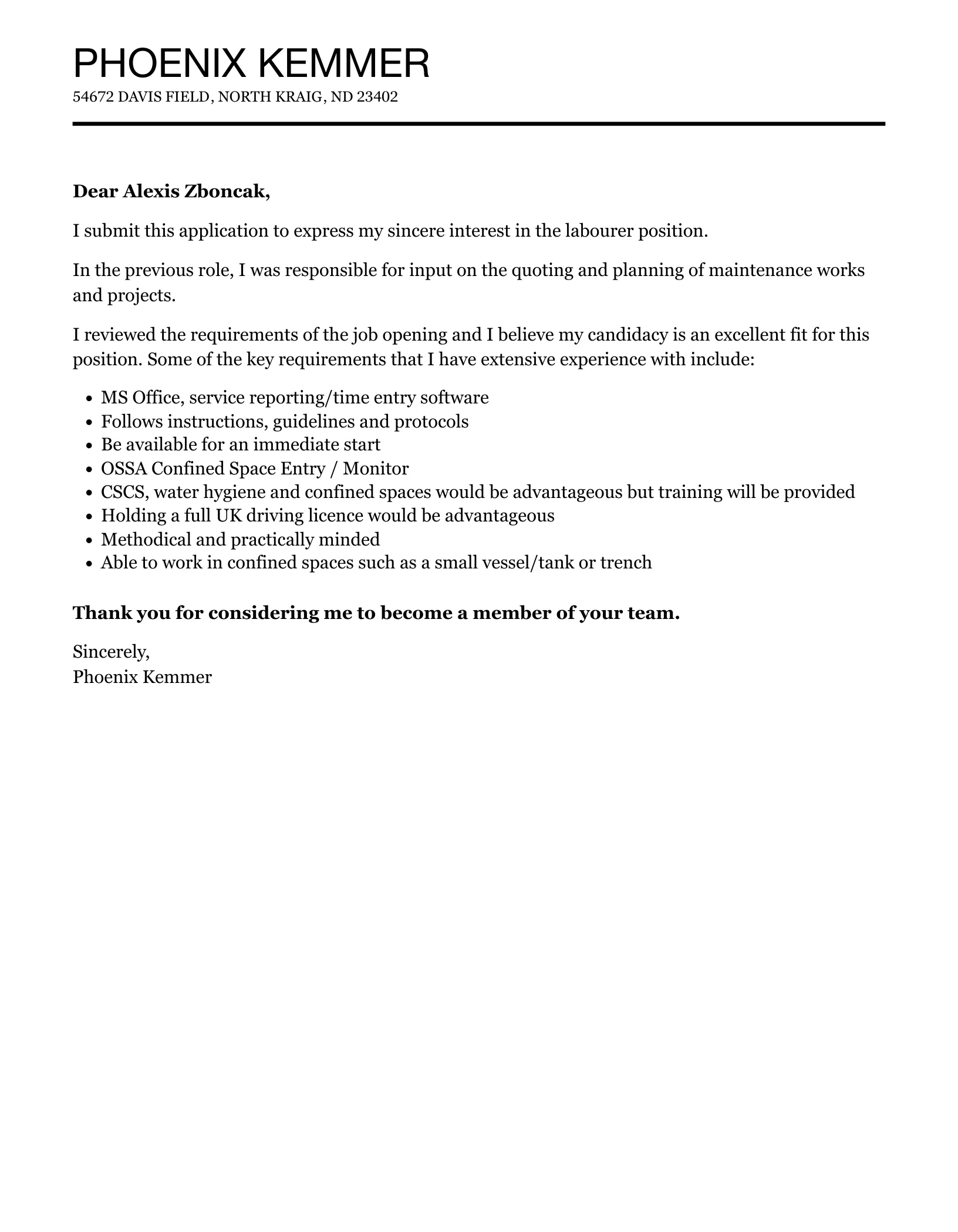
The body of your cover letter is the core of your application. It should consist of a few well-structured paragraphs. The first paragraph should state the position you are applying for and how you learned about the opportunity. The subsequent paragraphs should highlight your relevant skills, experience, and achievements. Use the job description as a guide, and tailor your content to the specific requirements outlined. For each skill or experience you mention, provide a specific example of how you have demonstrated it in the past. Conclude with a paragraph summarizing your interest in the role and reiterating your qualifications. Keep it concise and easy to read, avoiding long, convoluted sentences.
Closing and Call to Action
End your cover letter with a strong closing that expresses your enthusiasm and a clear call to action. Thank the hiring manager for their time and consideration. State your interest in an interview and mention how you can be contacted. Reiterate your key qualifications and why you are a good fit for the job. A well-crafted call to action prompts the hiring manager to take the next step. Close with a professional closing like ‘Sincerely’ or ‘Best regards,’ followed by your full name. Proofread your cover letter one final time before sending it to ensure there are no errors.
Tailoring Your Cover Letter for Each Job
One of the biggest mistakes job seekers make is using a generic cover letter for multiple applications. The most effective cover letters are tailored to the specific job and company. This demonstrates that you have taken the time to understand the requirements of the role and that you are genuinely interested in the opportunity. Tailoring involves researching the employer, analyzing the job description, and customizing your cover letter to highlight the skills and experience most relevant to that specific position. It also involves using the same keywords as the job description to pass through applicant tracking systems (ATS).
Researching the Employer and Job Requirements

Before you start writing, conduct thorough research on the company and the job. Visit the company’s website to understand its mission, values, and recent projects. Carefully read the job description and identify the key skills and qualifications the employer is seeking. Note the specific duties and responsibilities. Use this information to tailor your cover letter. Demonstrating that you understand the company and the requirements of the role significantly increases your chances of getting noticed. Highlight how your skills and experience match the employer’s needs, providing specific examples to support your claims. The more you show you understand the job, the more likely you are to stand out.
Customizing Your Cover Letter Content
Once you have researched the employer and the job, start customizing your cover letter. Use the job description to identify the most important skills and experiences the employer is looking for. Then, adjust your letter to highlight these qualifications, using the same keywords and phrases from the job description. Provide specific examples of how you have demonstrated these skills in previous roles. Tailor each section of the cover letter to the specific requirements of the job. Your goal is to make it clear that you are a strong match for the role. By showing a clear understanding of the job duties, you are showing the employer that you are prepared to make an immediate contribution.
Proofreading and Editing for Perfection
Before submitting your cover letter, it’s essential to proofread and edit it carefully. Errors, such as typos, grammatical mistakes, and formatting issues, can create a negative impression and undermine your chances of getting hired. Proofreading involves reviewing the letter for any errors in spelling, grammar, punctuation, and formatting. Editing involves reviewing the content for clarity, conciseness, and relevance. A polished cover letter demonstrates professionalism and attention to detail. A well-edited and proofread letter shows that you value your application and are committed to presenting yourself in the best possible light.
Common Mistakes to Avoid in Labourer Cover Letters
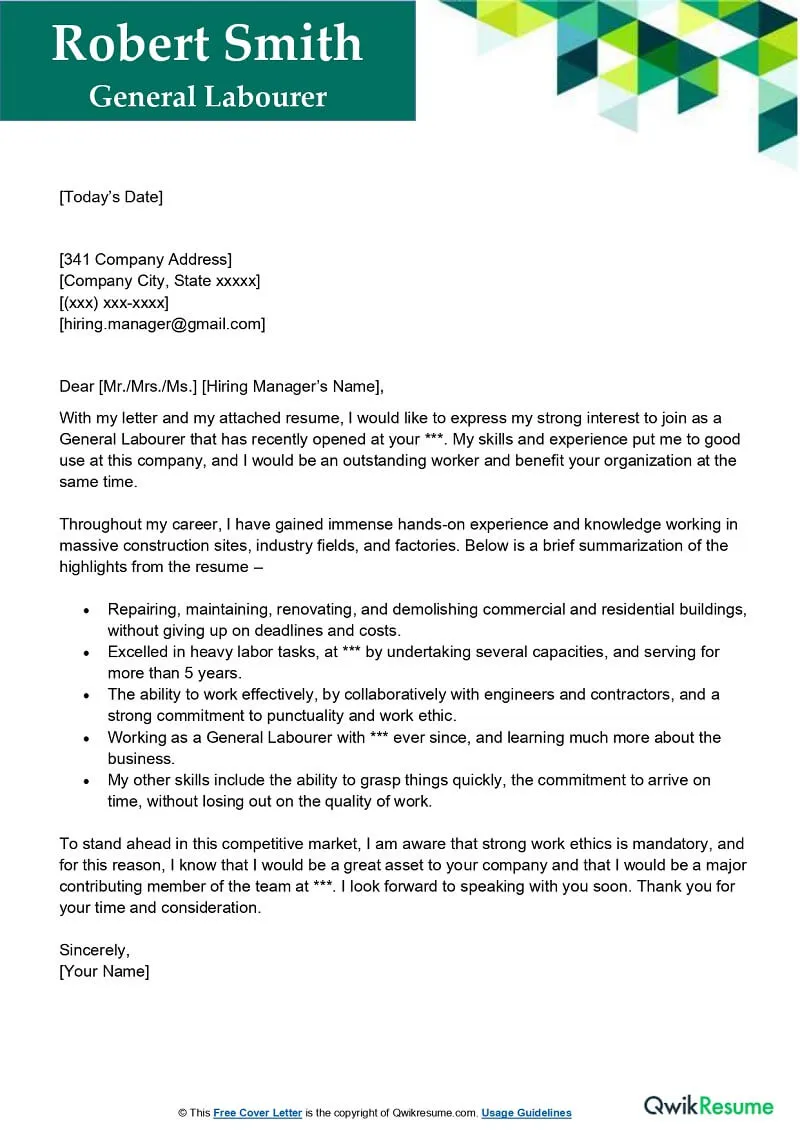
There are several common mistakes that can undermine a labourer’s cover letter. One major error is using a generic letter that is not tailored to the specific job. Another mistake is failing to highlight relevant skills and experience and simply listing job duties. Also, be careful about using jargon or overly complex language, as this can make your letter difficult to understand. Always check for grammatical errors and typos, as these can distract the reader. It is very important to avoid negative language and focus on your achievements and qualifications. Poor formatting and an unprofessional tone can also create a bad impression.
Ensuring Professionalism and Clarity
Your cover letter is a professional document, so it’s essential to maintain a high level of professionalism. Use a clear and concise writing style, avoiding slang or informal language. Be respectful and courteous in your tone. Proofread your letter carefully to eliminate any errors. Use a professional font and formatting. Ensure that your letter is easy to read and understand. Your letter is a representation of your communication skills. You want to project a positive image. By adhering to these principles, you can create a cover letter that showcases your skills and experience and helps you stand out from the competition.
